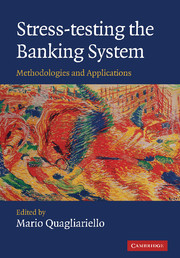Book contents
- Frontmatter
- Contents
- List of figures
- List of tables
- List of boxes
- List of contributors
- Foreword
- Acknowledgements
- Introduction
- Part I Fundamentals
- Part II Applications
- 8 Stress-testing credit risk: the Italian experience
- 9 Stress-testing US banks using economic-value-of-equity (EVE) models
- 10 A framework for integrating different risks: the interaction between credit and interest rate risk
- 11 Stress-testing linkages between banks in the Netherlands
- 12 An integrated approach to stress-testing: the Austrian Systemic Risk Monitor (SRM)
- 13 From macro to micro: the French experience on credit risk stress-testing
- 14 Stress-testing in the EU new member states
- 15 Cross-border macro stress-testing: progress and future challenges for the EU
- 16 Stress-testing at the IMF
- Conclusions
- Index
- References
8 - Stress-testing credit risk: the Italian experience
from Part II - Applications
Published online by Cambridge University Press: 18 December 2009
- Frontmatter
- Contents
- List of figures
- List of tables
- List of boxes
- List of contributors
- Foreword
- Acknowledgements
- Introduction
- Part I Fundamentals
- Part II Applications
- 8 Stress-testing credit risk: the Italian experience
- 9 Stress-testing US banks using economic-value-of-equity (EVE) models
- 10 A framework for integrating different risks: the interaction between credit and interest rate risk
- 11 Stress-testing linkages between banks in the Netherlands
- 12 An integrated approach to stress-testing: the Austrian Systemic Risk Monitor (SRM)
- 13 From macro to micro: the French experience on credit risk stress-testing
- 14 Stress-testing in the EU new member states
- 15 Cross-border macro stress-testing: progress and future challenges for the EU
- 16 Stress-testing at the IMF
- Conclusions
- Index
- References
Summary
Introduction
In Italy a wide variety of approaches is used to measure the exposure of the banking system to different risks and its resilience to several kinds of shocks. Most stress-testing methodologies have been designed in 2004 within the International Monetary Fund (IMF) Financial Sector Assessment Program (FSAP) and subsequently improved. In line with other countries' experience, the FSAP stress tests examined the impact of different shocks on the major Italian banking groups. The tests included both sensitivity and scenario analyses and they were performed using both top-down and bottom-up approaches, which provided sufficiently comparable results.
In this chapter we focus on credit risk for two reasons. First, it represents the most relevant risk Italian banks deal with. Second, while stress test procedures and sensitivity analyses for market risk are relatively better developed, there are no standardised methodologies for measuring the evolution of credit risk under different stress scenarios.
During the FSAP, the sensitivity exercise has been realised considering a 60 percent increase in the probability of default (PD) for all domestic exposures of Italian banks. This figure is slightly greater than the largest change historically observed in Italy (i.e., a 54 per cent increase in PD in 1993, after the European Monetary System (EMS) crisis). Sensitivity exercises are clearly very simple frameworks, in which PDs increase under a ceteris paribus assumption. To remove such an assumption scenario analyses have also been carried out along with single factor stress tests.
- Type
- Chapter
- Information
- Stress-testing the Banking SystemMethodologies and Applications, pp. 133 - 148Publisher: Cambridge University PressPrint publication year: 2009



